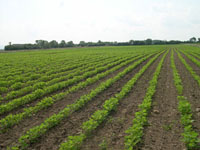Identifying Crop Damage by Vertebrates


This page contains a series of questions that will guide you in determining the wildlife species that is damaging your crops. Vertebrates are animals with backbones or spinal columns.
Is the damage occurring to:
Corn? |
Soybeans? |
 |
 |
Corn
Corn Damage Identification by Species
Beaver Damage to Corn
Key signs:
- Stalks cut near the base at a 45° angle. Stalks carried away toward water.
- Look for trail leading to water.
Bird Damage to Corn
Key signs:
- Stalks will not be knocked over
- Seedlings will be plucked prior to seed exhaustion
- Birds tend to dig around the entire seedling (squirrels to 1 side)
- Corn cobs will have a “firecracker” look.
- Corn seeds on the cob will be punctured
Black Bear Damage to Corn
Key signs:
- Typically, bears damage corn in the middle of the field. It’s not uncommon to only notice the damage at harvest time because their activity will not be visible from the edges.
- Stalks will be bent at the base and/or husks removed from stalk.
- Very wasteful eating as most of the corn will remain on eaten cobs.
Deer Damage to Corn
Key signs: 
- Tracks:
- Deer are browsers, so damage will be scattered throughout the field, but more concentrated near their travel areas and along the wood’s edge.
- Note how the cob has been bitten in half.
- Corn plants are susceptible to deer damage, not just the cobs. See Purdue’s publication (2020).

Raccoon Damage to Corn
Key signs:
- Stalks knocked over in different ways.
- Husks stripped off the cob (like we would) before eaten.
- Cobs will frequently have a muddied appearance as dirt from the raccoons paws will transfer to the cob.
Squirrel Damage to Corn
Key signs:
- Damage tends to occur close to wooded areas.
- Hearts of the corn will be eaten.
- Look for scattered pieces of corn on the ground.
- Seedlings will be plucked prior to exhaustion of the seed.
Soybeans
Soybean Damage Identification by Species
Deer Damage to Soybeans
Key signs:
- Cuts to stem will have a ragged appearance because deer lack upper incisors. In contrast, damage caused by woodchucks or rabbits will have a clean cut appearance, often at a 45 degree angle.